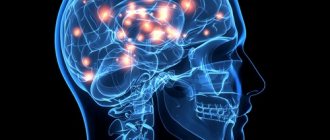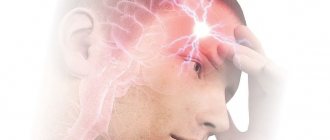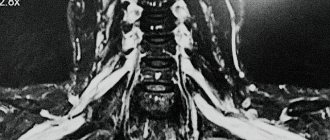Vegetovascular dystonia (VSD) is one of the few syndromes in medicine that causes a lot of disagreement among doctors. There are still no uniform criteria for diagnosis and therapy, so patients have to face many difficulties. Treatment of VSD should begin from the moment you seek medical help, and in modern realities a person has to undergo many examinations. As a result, the patient continues to experience painful symptoms of vegetative-vascular dystonia, and the doctor does not understand how to cure VSD and again sends the patient for further examination. This vicious circle can last from several months to several years.
What is VSD?
To explain the symptoms and treatment of VSD, it is necessary to have an understanding of the regulation of our body’s activities. The functioning of all internal organs is ensured by complex and multi-level relationships between the central and peripheral nervous systems.
The central cord includes the brain and spinal cord. The peripheral nervous system is represented by numerous nerve endings in organs and tissues. Some of them are under the conscious control of a person, for example, if you want to make some kind of movement, an impulse from the brain arrives to the nerve ending in the muscles. This section is called the somatic nervous system.
The other department is vegetative. It is responsible for the work of all internal organs and changes their activity, depending on environmental factors, physical activity of a person or his psycho-emotional status. This part of the nervous system works independently, that is, a person’s volitional efforts are not able to influence its activity.
The autonomic nervous system is responsible for the activity of all internal organs. Moreover, it also consists of two sections: sympathetic and parasympathetic. In their action, they have opposite effects on organs. For example, the sympathetic department increases the contractile activity of the heart, and the parasympathetic department reduces the frequency and strength of heart contractions.
In medicine, the term VSD is understood as a pathological condition when the normal relationship between two parts of the autonomic nervous system is disrupted. There is still no consensus among doctors about this syndrome.
Some clinicians do not consider VSD as a disease, but rather as a reversible pathological process based on dysfunction of the nervous system. At the same time, without timely correction, vegetative-vascular dystonia can develop into a disease of the heart, blood vessels, gastrointestinal tract or nervous system.
Many doctors agree that the syndrome is of a mental nature. All complaints with which the patient comes to the appointment are regarded as psychosomatic, that is, “arising” from mental and emotional disorders.
Despite disagreement about what it is, VSD requires complex treatment. The existing symptoms of vegetative-vascular dystonia have a pronounced negative impact on the condition of patients.
Symptoms of vegetative-vascular dystonia
Thus, it is already clear that vegetative-vascular dystonia can manifest itself in radically different ways. This concept “protects” various symptoms that arise in response to disturbances in the functioning of the autonomic nervous system.
In most cases, VSD occurs latently. But under the influence of overload or other unfavorable factors, an attack develops. Often they arise suddenly and unsettle a person. They are most difficult for older people, since they usually already have a number of other diseases, which aggravates the situation.
Often there are signs of other diseases that are not directly related to the autonomic nervous system or brain. But if manifestations of disturbances in the functioning of the cardiovascular system are observed, the neurologist has good reason to assume the presence of VSD.
The most common complaints of patients who are subsequently diagnosed with vegetative-vascular dystonia are:
- headaches of varying degrees of intensity and duration, migraines;
- attacks of dizziness;
- increased sweating;
- increased heart rate;
- severe weakness, increased fatigue;
- fluctuations in body temperature;
- noise in ears;
- darkening of the eyes, sometimes followed by fainting;
- constant drowsiness;
- increased anxiety, panic attacks;
- sudden mood swings;
- obsessive syndromes, hypochondria.
A panic attack is a strong fear of imminent death that completely grips the patient. The attack begins with the onset of anxiety, which gradually increases and turns into genuine horror. This is explained by the fact that the body sends signals of danger, but does not see options for exiting the situation. The attack lasts on average 10–15 minutes, after which the patient’s well-being gradually returns to normal.
Causes and predisposing factors
The causes of VSD remain the subject of debate. These are due to differences in opinion about what the syndrome itself is. A number of doctors perceive vegetative-vascular dystonia as a consequence of diseases of any organs. The appearance of symptoms of vegetative-vascular dystonia is explained by secondary disturbances in nervous regulation against the background of the existing disease. For example, with cardiac manifestations of VSD, the doctor begins to look for pathology of the heart and blood vessels. Failures in finding the disease are explained by incomplete laboratory and instrumental examination of the patient.
Modern medicine is of the opinion that VSD is caused by excessive overload or disturbances in the psycho-emotional sphere. The variety of symptoms that mimic the pathology of internal organs is actually a manifestation of psychological stress. This is confirmed by laboratory and instrumental data. During the examination of the patient, no abnormalities in the internal organs are revealed.
Autonomic dystonia is part of the group of neurotic disorders (neuroses). This group of conditions is determined by the characteristics of the response to stressful situations. At the same time, in a number of patients, the symptoms of VSD (cardiac, gastrointestinal, respiratory) come to the fore and are accompanied by painful experiences.
The psychogenic nature of vegetative-vascular dystonia is also explained by the variety of mental disorders in patients with this diagnosis. Somatic (organ) manifestations are often combined with anxiety-phobic and obsessive-compulsive disorders, depression. When taking a detailed history, patients are found to have had traumatic situations in the past, signs of social maladaptation, family and interpersonal problems.
In addition to psychoemotional disorders, the following factors play a role in the development of VSD:
- hereditary and constitutional features of the autonomic nervous system;
- unfavorable course of pregnancy, childbirth and the early postpartum period;
- diseases of the central nervous system;
- characteristics of the patient’s character and personality;
- hormonal imbalance;
- excess body weight;
- infectious diseases;
- suffered acute and chronic diseases, as well as surgical interventions.
A special place in the causes of vegetative-vascular dystonia is given to lifestyle disorders. Predisposing factors may include a sedentary lifestyle, disturbances in sleep-wake cycles, bad habits, monotonous work, mental and physical stress.
Causes of vegetative-vascular dystonia
VSD can develop against the backdrop of a huge number of diverse factors. Among them are especially distinguished:
- psychological – severe or constant stress, depressive states;
- physical – severe physical fatigue, exposure to vibration, high temperatures, sunstroke;
- chemical – addiction to alcohol, nicotine, narcotic substances, taking a number of medications, in particular those containing ephedrine, caffeine, bronchodilators;
- changes in hormonal levels - adolescence, pregnancy and lactation, menopause, use of hormonal contraceptives, especially with frequent periods of withdrawal;
- infectious – acute and chronic diseases of the respiratory system, kidneys, brain;
- neurological disorders - Parkinson's disease, traumatic brain injury;
- endocrine diseases – diabetes mellitus, thyrotoxicosis;
- pathologies of the cardiovascular system - arterial hypertension, coronary artery disease.
It is believed that the main cause of the development of VSD is stress.
But not all people who have even several of the listed diseases develop vegetative-vascular dystonia. Women suffer from it 2 times more often than men, and almost half of all cases of VSD diagnosis occur in young girls who have not yet turned 25 years old. And only 33% of women with vegetative-vascular dystonia are over 25 years old.
Heredity plays a significant role in assessing the risk of VSD. Very often it first appears in childhood or adolescence. As one gets older, the disorder can be compensated and the attacks disappear. But the impact of negative factors can reverse the situation and again provoke the occurrence of vegetative-vascular dystonia.
The impetus for its development can be:
- psychological characteristics of the individual, especially suspiciousness and a tendency towards hypochondria;
- unfavorable socio-economic, environmental conditions (lack of sunlight, sedentary lifestyle, lack of funds, lack of nutritional culture, consumption of cheap, low-quality products, etc.);
- intrauterine pathologies - infections, hypoxia, fetoplacental insufficiency, rhesus conflict, etc.
Sometimes VSD is a transient reaction to any strong emotional shocks or emergency situations.
Kinds
There is still no unified classification of vegetative-vascular dystonia that would take into account the diversity of its manifestations. In medical practice, VSD is most often divided into several types:
- vagotonic – the clinical picture is due to the predominance of the parasympathetic department over the sympathetic one (low blood pressure, chills, dizziness, lightheadedness, “lump in the throat” and others);
- sympathicotonic - symptoms are associated with hyperfunction of the sympathetic department (increased blood pressure, rapid heartbeat, feeling of heat);
- mixed - both types of symptoms may be present in the clinical picture.
Depending on the mechanism of development, the syndrome is divided into two types: primary and secondary. The primary form of VSD occurs independently, the secondary form occurs against the background of existing diseases of various localizations.
Vegetative-vascular dystonia is also divided into subtypes depending on organ symptoms. Here are several clinical variants of VSD:
- changes in the cardiovascular system;
- disruption of the gastrointestinal tract;
- psychoemotional and nervous disorders;
- changes in the functioning of the respiratory system.
The most common VSD involves the cardiovascular system. This type of syndrome has its own name - neurocirculatory dystonia. It is divided into several clinical subtypes.
| Hypertensive | Hypotonic | Cardiac |
| Characterized by increases in systolic blood pressure, palpitations and interruptions in heart function. Combined with other manifestations of sympathicotonia (for example, hot flashes, sweating). | It is characterized by lowering blood pressure and slowing heart rate. Other symptoms include signs of vagotonia (dizziness, fainting, and others). | The main complaint is pain in the heart area of varying nature and severity. Most often, the pain is stabbing and occurs against the background of emotional stress. |
Any of the listed variants of vegetative-vascular dystonia can be of three degrees of severity: mild, moderate or severe. The severity of the condition is assessed based on the client’s complaints and the severity of clinical manifestations.
The course of VSD can be permanent (constant) or paroxysmal (paroxysmal). The first variant of the syndrome is spoken of in cases where the symptoms bother you almost every day and are mild or moderate. A vegetative-vascular attack begins suddenly against the background of the patient’s relative health and is accompanied by a significant deterioration in the general condition. As a rule, an attack is provoked by overwork or psycho-emotional stress.
Clinical manifestations
The whole variety of symptoms of autonomic dysfunction can be divided into several groups. In this case, the organ localization of manifestations of vegetative-vascular dystonia is taken into account.
Cardiovascular manifestations
Cardiovascular symptoms in adults and children are very common with VSD. The main ones are cardialgia (pain in the heart) and various rhythm disturbances. Most often, heart pain appears suddenly against the background of previous emotional stress, less often they are observed at rest. They have a stabbing character. Patients themselves usually describe the pain syndrome with the phrase “stabbing like needles,” pointing to the area of the heart.
The duration of pain varies. For some it is a single tingling sensation, for others it is a long-term discomfort. The pain can also radiate to the shoulder girdle, left arm or shoulder blade, and less commonly to the right half of the body. Such symptoms sometimes cause suspicion among doctors due to the similarity of clinical manifestations with coronary heart disease, in particular with angina pectoris.
Rhythm disturbances are represented by its slowdown or acceleration (brady- and tachycardia). Bradycardia is usually not felt by the patient and is detected during examination. An increased heart rate may be perceived as palpitations. Less common are extrasystoles, which are felt as a “fading” of the heart.
This group of symptoms also includes an increase or decrease in blood pressure (hypertensive and hypotonic type of syndrome). The vascular manifestations of VSD are diverse. They are mainly represented by chilliness and freezing, coldness of the extremities, and pallor of the skin.
The most pronounced cardiovascular signs of vegetative-vascular dystonia are in patients suffering from paroxysms. During an attack, the symptoms sharply worsen, and in addition to them, uncontrollable fear, a feeling of lack of air, and others appear.
Gastrointestinal manifestations
Symptoms of VSD from the digestive organs are varied. They can be combined into two large groups: dyspepsia and irritable bowel syndrome. In the first case, the patient's complaints are presented as follows:
- pain in the projection of the stomach or esophagus of varying intensity, not having a clear relationship with food intake;
- belching air;
- feeling of fullness in the stomach, distension;
- flatulence;
- nausea;
- unpleasant taste in the mouth, often metallic or bitter;
- tendency to diarrhea or constipation.
Such symptoms are similar to manifestations of a peptic ulcer, but when examining the patient, no signs are found. The listed complaints bother patients for a long time, and drug therapy does not provide a lasting effect. Disorders of the gastrointestinal tract often cause a decrease in appetite and body weight.
Another type of disorder with autonomic dystonia is irritable bowel syndrome. Its main manifestations are stool upset and widespread abdominal pain. At the same time, the patient’s appetite does not suffer, and body weight remains the same. Painful sensations can be long-lasting and aching, or acute, paroxysmal (like spasms). Stool disorders are represented by diarrhea (defecation three times a day or more often) or constipation (stool less than three times a week).
Respiratory symptoms
The main respiratory symptoms of VSD are represented by neurogenic respiratory disorders. The respiratory system, although considered autonomous, is still closely connected with the emotional state. Anxiety and low mood play a special role here.
Under the influence of a psychogenic factor, the rhythm of normal breathing is disrupted. It becomes faster and deeper. As a result, hyperventilation develops, which can lead to biochemical changes. A patient with respiratory disorders experiences hypocapnia (lack of CO2 in the blood) and respiratory alkalosis (alkalization of the blood). These shifts can lead to pain and other sensory disturbances, which again triggers breathing failure.
Respiratory disorders may include the following:
- labored breathing;
- feeling of lack of air;
- violation of the frequency and depth of breathing;
- equivalents of hyperventilation (frequent sighs, coughing, yawning).
Respiratory symptoms of VSD are sometimes referred to as “empty breath.” The patient's main complaints are dissatisfaction with inhalation and a feeling of lack of air. The constant feeling of lack of air is manifested not only by deep breaths. Patients do not tolerate hot weather and prolonged stay indoors.
Respiratory disorders are more pronounced in crowded places or during stressful situations. In the paroxysmal form of VSD, respiratory disorders are of the nature of a hyperventilation crisis and are expressed to a significant extent.
Nervous and psychoemotional disorders
This group of symptoms is regarded by most doctors as the main one. Mental and emotional disorders in VSD are most pronounced. They can be represented as follows:
- increased anxiety and constant nervousness;
- lability (swings) of mood, a tendency to decrease;
- various types of phobias (fears), especially social ones;
- panic disorders;
- sleep disorders;
- obsessive thoughts and actions (constant hand washing, checking things);
- non-acceptance of oneself;
- loss of interests and desire to do anything;
- inability to enjoy or take pleasure in anything.
Neurological symptoms also include fainting. They are more often observed in adolescents and young adults. The mechanism of their development is associated with a short-term decrease in cerebral circulation. Fainting can last from a few seconds to several minutes. It is not accompanied by convulsions, and after fainting there may be general weakness and a feeling of weakness.
In most patients, true neurological disorders (primary headaches, neurogenic fainting) or mental illnesses are hidden under the “mask” of VSD. The fact is that the diagnosis of VSD is only a statement of the fact that the patient has some somatic symptoms. The root cause of these complaints remains unknown to general practitioners.
Somatic manifestations of VSD in psychiatry are almost always considered as a consequence of mental disorders, especially the anxiety spectrum. The range of mental disorders that have symptoms of vegetative-vascular dystonia includes depression, anxiety-phobic disorders, mania and neurotic-type syndromes.
Other symptoms
VSD can also manifest itself as thermoregulation disorders. A number of patients may experience a rise in temperature due to emotional stress, more often in the morning. This may be accompanied by a feeling of heat and profuse sweating. Temperature rises are more often observed in the autumn-winter period.
With the vagotonic type of VSD, patients blush easily in stressful situations. The skin has a cyanotic (blue) color, moist and cold. Upon closer examination, a vascular pattern is revealed, giving the skin a marbling appearance.
Vagotonia is also characterized by excessive greasiness of the skin and a tendency to acne. Sympathicotonia, on the contrary, is characterized by dry skin and a tendency to peel. Sweating in patients is scanty.
Treatment of vegetative-vascular dystonia
Treatment of VSD is always selected strictly individually. In this case, the neurologist must take into account a lot of factors and formulate the optimal tactics. Not only the type of vegetative-vascular dystonia, the severity and frequency of attacks, the patient’s age, but also the presence of concomitant diseases and their characteristics are taken into account.
When prescribing treatment for patients with VSD, neurologists pursue two goals: eliminating the symptoms of vegetative-vascular dystonia and influencing the cause of the development of dysfunction of the autonomic nervous system. The second task is of particular importance, since sometimes it is not possible to find the true cause of VSD. But the patient’s quality of life in the future primarily depends on this, since by eliminating the cause of VSD, the cause itself will also be eliminated. Therefore, treatment of vegetative-vascular dystonia is often carried out not only by a neurologist, but also by other specialized specialists, in particular, a cardiologist.
Also, treatment of vegetative-vascular dystonia involves influencing the psycho-emotional state of patients, since stress and prolonged nervous tension definitely do not improve their condition.
Thus, the treatment of vegetative-vascular dystonia is always complex. It includes:
- drug therapy;
- lifestyle correction;
- psychotherapy;
- Spa treatment.
To combat the causes of VSD, manual therapy is often used. This is due to the fact that a competent effect on the spine can improve the performance of almost every organ of the human body. After all, it is in the spinal cord that the autonomic centers are located, which suffer greatly in the presence of spinal pathologies.
Therefore, the elimination of scoliosis, protrusions, herniated intervertebral discs, spondylosis and other disorders necessarily leads to a significant improvement in the condition of patients, and when treated in the early stages, a complete elimination of the causes of the development of VSD.
One of the most effective methods of manual therapy is the original Gritsenko method. With its help, you can restore the normal position of each vertebra and thereby completely normalize the functioning of the spinal cord. As a result, blood circulation also improves, back and chest pain, breathing problems, and a host of other disorders go away. An additional “bonus” is an increase in the body’s adaptive capabilities and a slowdown in the natural aging process.
When manual therapy is performed correctly, improvements are observed after the first sessions. But to consolidate the results and eliminate the causes of vegetative-vascular dystonia, you need to undergo a course of manual therapy. Moreover, sessions can be combined with work, study, business trips and other activities.
Drug therapy
Treatment of VSD involves the use of a whole range of medications, the list of which, as well as the dosage, is determined by the neurologist on an individual basis. Thus, drug therapy for vegetative-vascular dystonia may include:
- Antidepressants help eliminate excessive anxiety, increased irritability and help overcome depression, psycho-emotional stress, and apathy. Often, while taking antidepressants, there is a decrease in heart pain and muscle pain, even in cases where they previously could not be relieved by other means.
- Tranquilizers - used to reduce the risk of panic attacks, eliminate causeless fears and relieve increased anxiety.
- Sedatives - initially preference is given to herbal remedies, but if they do not have the desired effect, they are replaced with “heavy artillery”. Herbal remedies act gently; in the absence of allergies, they do not have a negative effect on the body, but have a beneficial effect on the nervous system.
- Nootropics are designed to activate blood circulation in the vessels of the brain, remove the negative effects of hypoxia (oxygen deficiency) and increase the body’s ability to resist stress.
- Adrenergic blockers are prescribed when problems with the heart are detected.
- Diuretics - used in the presence of headaches, attacks of dizziness that occur against the background of increased intracranial pressure or arterial hypertension. They help remove excess fluid from the body, but lead to a decrease in sodium levels, and some potassium levels. This can negatively affect the functioning of the heart, so diuretics are often combined with drugs that replenish the deficiency of these ions.
- Vitamin preparations containing B vitamins improve the conductivity of nerve impulses and generally have a positive effect on the state of the nervous system as a whole.
- Metabolic drugs - designed to increase control over glucose levels, have microcircular, antihypoxic properties.
Lifestyle correction
In order to improve the functioning of the autonomic nervous system, patients with VSD are recommended to reconsider their lifestyle and habits. Thus, neurologists recommend to all patients:
- Organize the correct work and rest schedule. During the workday, it is important to take breaks, leave your chair and go for a walk to improve blood flow in the body and give your head a chance to rest.
- Get enough sleep. It is recommended to sleep at least 8 hours every day.
- Walk outdoors every day. It's worth walking for about an hour. This is enough to improve the functioning of the entire body.
- Make moderate physical activity an integral part of your life. Fanatical exercise with VSD will be detrimental, but half an hour of jogging, aerobics, and swimming will be very helpful.
- Eat properly. Patients are advised to avoid foods with a high content of trans fats, which contribute to the formation of atherosclerotic plaques and also increase nervous excitability. But a strict diet for VSD is not indicated, since strict restrictions can negatively affect the psycho-emotional state of the patient, which will aggravate the course of vegetative-vascular dystonia.
Since the topic of nutrition in VSD raises many questions, it requires a more detailed consideration. With such a diagnosis, the diet should be built in accordance with the following principles:
- enriching the diet with foods that are sources of potassium and magnesium and have a positive effect on the functioning of the cardiovascular system, in particular blood pressure levels;
- normalization of water-salt balance by drinking 1.5 liters of water per day, in addition to tea, juices and other drinks;
- enjoying food;
- bringing the diet as close as possible to the requirements of a healthy diet.
The nature of the diet may vary depending on the type of vegetative-vascular dystonia. So, in case of hypertensive form, it is important to exclude foods containing large amounts of “hidden” salt. For this purpose, it is recommended to refrain from eating fast food, canned food, marinades, semi-finished products, etc. Instead, patients are asked to include soups with vegetable or weak meat or fish broth in their daily menu. It is also recommended to replace traditional wheat or rye bread with products made from whole grain flour or with bran.
With hypotonic VSD, when creating a menu, you should pay special attention to vegetables and fruits that contain increased amounts of well-absorbed vitamin C and β-carotene, as well as foods that increase blood pressure. Thus, with this form of dysfunction of the autonomic nervous system, it is worth introducing into the daily diet:
- citrus fruits, bananas, bell peppers, pineapples, pomegranate;
- any nuts, buckwheat, liver, brains;
- cheeses;
- herring;
- dark chocolate, cocoa, coffee.
With hypotonic VSD, it is not prohibited to eat white bread, potatoes and even sweets.
If a patient is diagnosed with a cardiac form of the disease, he is recommended to bring foods that are a source of magnesium and potassium to his table. This will have a positive effect on the functioning of the heart muscle and reduce the risk of developing dangerous complications. Therefore, they should pay attention to:
- oatmeal, buckwheat;
- legumes;
- onions, eggplants;
- apricots, peaches, grapes, including in the form of dried fruits;
- natural juices, compotes, jelly;
- dairy products;
- chicken eggs;
- lean varieties of fish and meat.
Psychotherapy
With vegetative-vascular dystonia, it is important not to close yourself off from the problem, but to solve it. Therefore, competent psychotherapy plays a significant role in the treatment of VSD. Psychotherapy helps you understand yourself better, become calmer and more confident.
Spa treatment
An annual holiday in a sanatorium outside the period of exacerbation of vegetative-vascular dystonia has a positive effect on the physical and psycho-emotional state of people, which helps to prolong remission. But with VSD, long trips abroad will not be the best idea. It would be more correct to choose a balneological resort in the climatic zone in which he permanently lives, since a sharp change in climate can negatively affect a person’s condition and provoke a new exacerbation of VSD.
Sudden vegetative-vascular attack
The so-called “vegetative-vascular crises”, which in practice occur like panic attacks, deserve special attention. The sudden onset of feelings of fear and anxiety is accompanied by severe somatic symptoms (palpitations, inability to breathe). They are extremely difficult for patients to tolerate and lead to complete social maladjustment. Moreover, a person is constantly in painful anticipation of a second attack.
In some patients, the attack appears suddenly. Others note a clear relationship with potentially threatening or stressful situations. This could be being in society, a cramped room or space, exciting news, etc.
In addition to severe anxiety and fear, the patient experiences palpitations, a lump in the throat, a feeling of lack of air and the inability to breathe. Choking, dizziness, increased heart rate, as well as disorientation in space and time lead to a feeling of fear of death. A panic attack often causes an ambulance to be called.
Correction of work activity
Competently drawing up a workday routine will help you fight vegetative-vascular dystonia. You cannot overwork and work overtime. Lunch must be used for its intended purpose. At this time, a person should have a snack, relax, and chat with colleagues. If your work activity involves sedentary work, it is recommended to get up from your desk every 40 minutes, do a warm-up, and walk around the office. For patients with pronounced signs of illness, the attending physician may advise them to change jobs.
Working conditions must meet all the necessary requirements for a patient with VSD
Diagnostics
The diagnostic program for suspected VSD is to exclude pathology of internal organs, the cervical spine, as well as impaired blood supply to the brain. The scope of the diagnostic program is determined by the attending physician based on the patient’s complaints. As a rule, a simple laboratory and instrumental examination is sufficient. For example, in case of cardiac complaints, an ECG, ultrasound of the heart, daily monitoring of pressure and heart rhythm, and stress tests are performed. For complaints of dizziness and darkening of the eyes, a duplex of the vessels of the head and neck, or an MRI of the brain in vascular mode. In many cases, a consultation with a psychotherapist is recommended, especially if no violations of the internal organs or the central or peripheral nervous system are detected.
Osteopathic diagnosis plays an important role. It allows you to identify those disorders that are “not visible” during instrumental examination. Often, the patient is referred to a psychotherapist, while the cause is quite “tangible” and can be perfectly treated with osteopathy. Diagnostics is based on the fine sensitivity of the hands of an osteopath and allows you to identify those areas of the body in which tissues are “tight,” move poorly, or affect other areas of the body, disrupting their normal function.
For example, with symptoms such as:
- dizziness, weakness;
- panic attacks;
- difficulty breathing;
- chest pain;
- chronic pain;
- heartbeat;
- high blood pressure;
- arterial hypotension;
- stomach ache.
Physiotherapy methods
Not only a healthy lifestyle and nutrition, but also the use of physiotherapy helps to get rid of vegetative-vascular dystonia forever. Water treatments will be useful. Hydrotherapy will help relieve muscle and psychological tension, improve blood and lymph circulation throughout the body, and improve metabolic processes. Among water procedures, swimming, massage, and gymnastics are used.
Another type of treatment is electrophoresis. This method is considered one of the most effective. It is often prescribed to patients with various pathologies during treatment in a sanatorium. Electrophoresis is carried out using many medications. These include medications including magnesium, calcium, potassium, Euphyllin, Papaverine, bromine, Novocaine and other drugs.
Therapy using electrophoresis is complemented by such techniques as Charcot's shower, electrosleep, UHF, thermal procedures, acupuncture, hirudotherapy, and massage.
Important! Physiotherapeutic treatment methods help to effectively remove many manifestations of VSD, even without internal medication.
Transformation of symptoms in men
Scientists are confident that the predominance of the syndrome in women is associated with social aspects. But even among representatives of the stronger sex, symptoms such as the body’s reaction to weather conditions, headaches, stomach dysfunction, and rapid heartbeat are not uncommon. Most often, representatives of the stronger sex are diagnosed too late. Representatives of the stronger sex are not used to going to the doctor for trifles. Most people use alcoholic beverages as medicine. Drinking alcohol can result in another panic attack. Most often, company is not required in this case, or new acquaintances appear who drag you into binge drinking. Oddly enough, in most cases, alcoholic drinks actually help. But prolonged consumption of alcohol has a detrimental effect on internal organs. Statistics show that 50% of men who were diagnosed with VSD had a tendency to drink excessively.
Use of exercise therapy
Is vegetative-vascular dystonia treated with physical therapy? Yes, exercise therapy really helps improve blood circulation, restore lymph flow, increase vascular tone, and relieve nervous tension. It is not recommended to choose sports such as weightlifting, boxing, and wrestling. Swimming, yoga, gymnastics, cycling, skiing and even regular walking are suitable for patients with VSD.
Physical education is a great way to improve your health and overall well-being.
Let's look at some exercises for VSD:
- tilts of the torso and head. To perform this, you need to place your feet shoulder-width apart and slowly turn your body to the left, then to the right. Repeat the exercise using the neck. Number of repetitions – 7–15 times;
- squats. Performed with a straight back, feet shoulder-width apart. To begin with, it is enough to do 7-10 repetitions. Every day the load can be increased;
- running in place and jumping. The exercise is considered cardio exercise, so it should be performed only with the permission of a doctor. Running and jumping are a great way to circulate blood throughout the body and improve your mood.
Important! If, while performing gymnastics, the patient feels shortness of breath or pain in the heart area, it is worth reducing the load or stopping the exercise.
What does non-drug therapy mean?
- exclusion of risk factors;
- mandatory eight-hour sleep and adherence to a daily routine;
- availability of sports activities;
- dietary menu developed for each individual;
- cervical massage;
- work with a psychologist;
- aroma oils.
We prescribe medications only when all of the above does not help and the disease significantly reduces the quality of life. In addition, during treatment we use the following methods:
- cold and hot shower;
- using laser therapy;
- vacuum.
An individual approach to the client is guaranteed! Most patients manage to achieve a positive result after 3-4 weeks.
Before prescribing the drug, employees will definitely conduct a comprehensive examination and rule out the presence of any neurological diseases.











